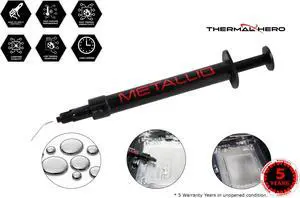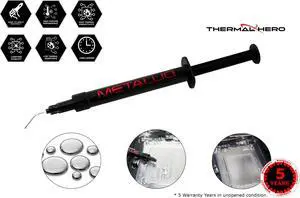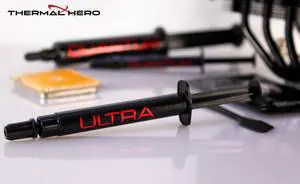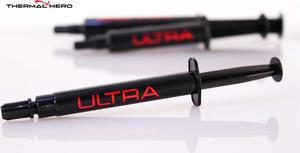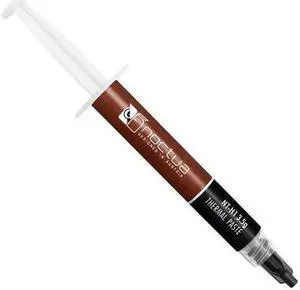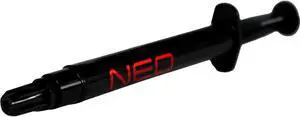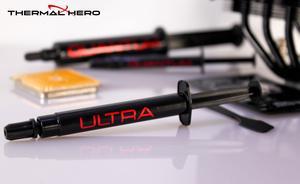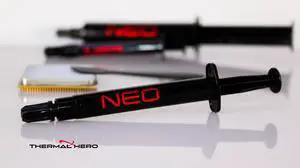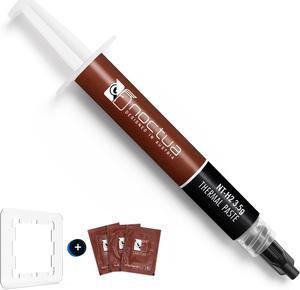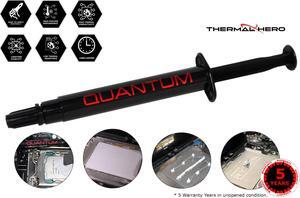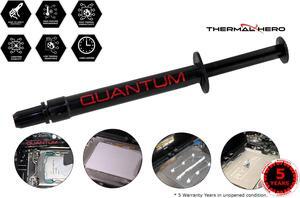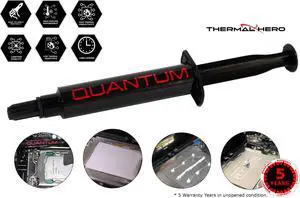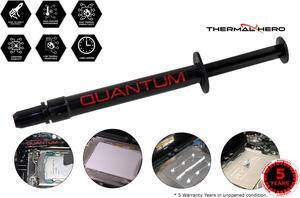Your Browsing History
Any questions? Our AI beta will help you find out quickly.
Try me now
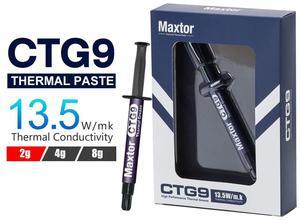
Quick View
Maxtor Thermal CTG9EL 13.5W/mk thermal paste,Gaming grade CPU/GPU/cooling fan overclocking thermal grease,High TDP device cooling solution
- Part Number: 9EL
- Volume / Net Weight: 2.0g
- Thermal Conductivity: 13.5 W/mK
- Long Term Operating Temperature: -50 to 250 C
- Model #: Newegg053
- $11.90 –
- Free Shipping
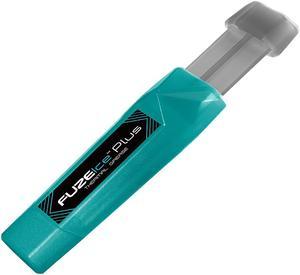
Quick View
Iceberg Thermal FUZEIce Plus Thermal Paste Heatsink Compound CPU GPU High Performance Grease (3.5g)
- Volume / Net Weight: 3.5g
- Model #: FUZEICEP4G-X0A
- $8.99 –
- Free Shipping
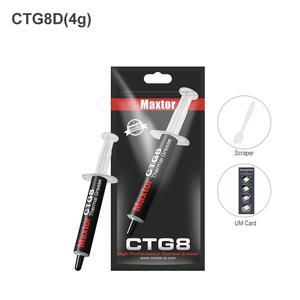
Quick View
in 30 days
Maxtor Thermal CTG8 12.8W/mk thermal paste,Gaming grade CPU/GPU/cooling fan overclocking thermal grease,High TDP device cooling solution,4g syringe installation- Volume / Net Weight: 4.0g
- Thermal Conductivity: 12.8W/mK
- Long Term Operating Temperature: -50 to 250 C
- Specifications: The thermal conductivity of CTG8D reaches 12.8W/mK, achieving above average performance on the market at a relatively moderate price. It can quickly reduce the temperature difference between CPU/GPU cores and meet the cooling needs of mainstream gaming laptops, desktop computers, and mid-range graphics cards. The non-conductive formula completely avoids the
- Model #: Newegg001
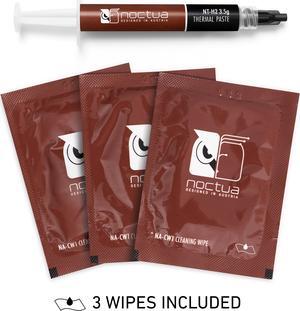
Quick View
Noctua NT-H2 3.5g, Pro-Grade Thermal Compound Paste w/ 3x cleaning wipes (3.5g)
- Specifications: Premium-grade thermal compound for optimal heat-transfer from the CPU or GPU to the heatsink
- Model #: NT-H2-3.5g
- $25.10 –
- More options from $25.05 - $38.87
- Free Shipping
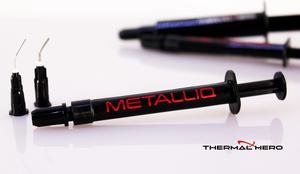
Quick View
THERMAL HERO METALLIQ (1g) LIQUID METAL PASTE for CPU | Extreme Overclocking | Xbox PS4 PS5
- Part Number: TH-108001
- Model #: TH-108001
- $27.23
- $27.22 –
- More options from $16.99 - $27.22
- Free Shipping
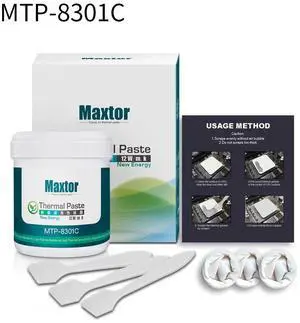
Quick View
Maxtor Thermal CPU Thermal Paste 12W/mk High-Performance Thermal Grease 150g - Premium Heat Conductive Compound for PC/GPU/PS4 Cooling Fans, Computer Heatsinks, MCU & 5G Devices
- Part Number: Canned thermal paste has a unit price about 50% lower than syringe packaging, and is more recommended for large consumer groups such as physical stores, server fields, power battery fields, aerospace fields, etc.
- Volume / Net Weight: 150g
- Thermal Conductivity: 12 W/mK
- Long Term Operating Temperature: -50 to 260 C
- Model #: Newegg027
- $42.90 –
- Free Shipping
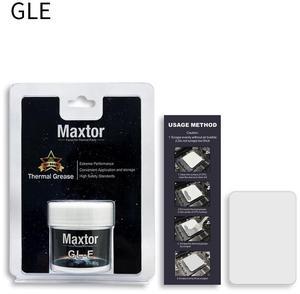
Quick View
Maxtor Thermal GLE Thermal Paste 10.5W/mk 50g - Multi-Device Thermal Grease for PC/CPU/PS4 Cooling, Game Consoles, MCU & Computer Heatsink Maintenance
- Volume / Net Weight: 50g
- Thermal Conductivity: 10.5W/mK
- Long Term Operating Temperature: -50 to 250 C
- Specifications: GEL canned thermal paste can be purchased at an extremely low price with a net content of 50g and a thermal conductivity coefficient of 10.5W/mK, which can quickly reduce the temperature difference between CPU/GPU cores and meet the cooling needs of mainstream gaming laptops, desktop computers, and mid-range graphics cards.
- Model #: Newegg005
- $16.99 –
- Free Shipping
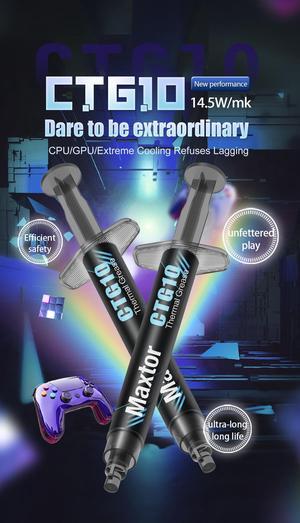
Quick View
Maxtor Thermal CTG10 14.5W/mk thermal paste,Gaming grade CPU/GPU/cooling fan overclocking thermal grease,High TDP device cooling solution,4g syringe installation
- Volume / Net Weight: 4.0g
- Thermal Conductivity: 14.5W/mK
- Long Term Operating Temperature: -50 to 250 C
- Specifications: The thermal conductivity of CTG10 thermal paste reaches 14.5W/mK, which can quickly reduce the temperature difference between CPU/GPU cores and meet the cooling needs of mainstream gaming laptops, desktop computers, and mid-range graphics cards. The non-conductive formula completely avoids the risk of short circuit, and can be easily extended into
- Model #: Newegg010
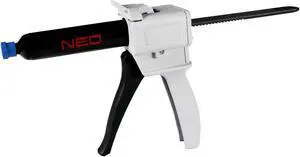
Quick View
THERMAL HERO NEO Series Thermal Paste 50g, High Thermal Conductive, For PC Cooling, Extreme Overclocking, Gaming, Xbox, Playstation, All Applications
- Volume / Net Weight: 50.0g
- Thermal Conductivity: 12 W/mk
- Long Term Operating Temperature: -50 to 240 C
- Specifications: Low Therm,al Resistance
- Model #: TH-201250
- $65.56 –
- Free Shipping
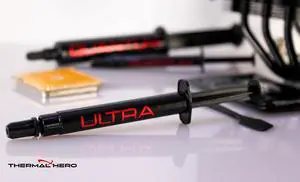
Quick View
THERMAL HERO ULTRA Series Thermal Paste 25g, Ultra High Thermal Conductive, For PC Cooling, Extreme-Overclocking, Gaming, Xbox, Playstation
- Model #: TH-301325
- $47.72 –
- Free Shipping
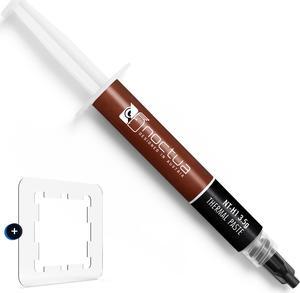
Quick View
Noctua NT-H1 3.5g AM5 Edition, Pro-Grade Thermal Compound with Thermal Paste Guard for AMD AM5 CPUs (3.5g)
- Model #: NT-H1 3.5g AM5 Edition
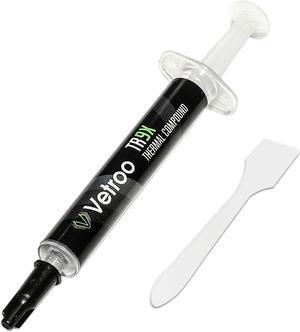
Quick View
Vetroo TR9X Thermal Paste, High Conductive Performance Heatsink Paste Thermal Compound Paste for All Processor/CPU/GPU Easy to Apply
- Model #: 794832619676
- $8.59 –
- Free Shipping
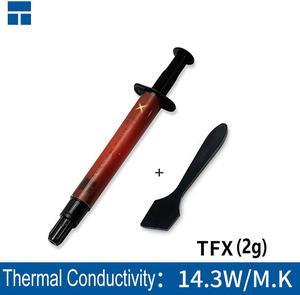
Quick View
Thermalright TFX 2g 14.3 W/mK thermal grease desktop computer cpu thermal paste heat dissipation silicone graphics card silicone paste
- Model #: 2205GUIuxi016
- $19.90 –
- Free Shipping
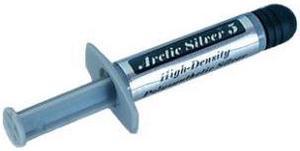
Quick View
2 pcs Arctic Silver 5 High-Density Polysynthetic Silver Thermal Compound AS5-3.5G
- Model #: AS5-3.5G x 2
- $27.99 –
- Free Shipping
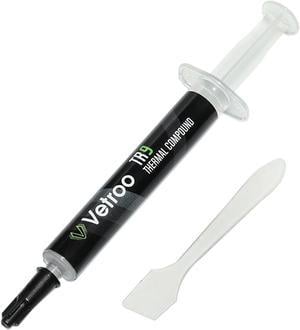
Quick View
Vetroo TR9 Thermal Paste, High Conductive Performance Heatsink Paste Thermal Compound Paste for All Processor/CPU/GPU Easy to Apply
- Model #: 794832619669
- $8.98 –
- Free Shipping
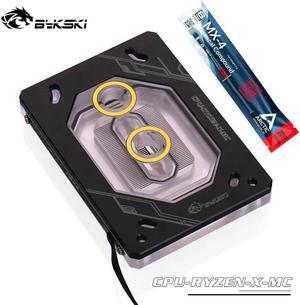
Quick View
Thermal Paste mx-4 + RYZEN3000 RyzenAM3/AM3+/AM4 1950X TR4 X399 X570 CPU Water Block Copper Radiator Water Cooler
- Model #: 1-CPUThermal0804
- $150.13 –
- Free Shipping
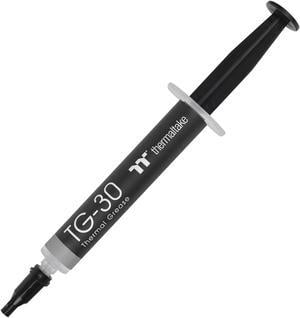
Quick View
Thermaltake TG-30 Premium CPU/GPU Heatsink Thermal Compound - 4g, CL-O023-GROSGM-A
- Volume / Net Weight: 4.0g
- Thermal Conductivity: 4.5 W/mK
- Long Term Operating Temperature: -50 to 200 C
- Specifications: Viscosity: 76 Pa-s Dimensions: 7.05" (L) x 3.5" (W) x 0.59" (H) Weight: 4 g Shelf Life: 24 months Color: Grey
- Model #: CL-O023-GROSGM-A
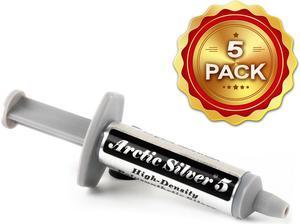
Quick View
- $39.99 –
- Free Shipping
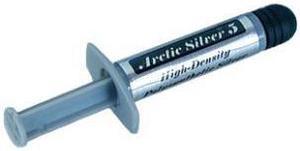
Quick View
Arctic Silver AS5-3.5G Thermal Compound
- Volume / Net Weight: 3.5g
- Long Term Operating Temperature: -50 to 130 C
- Specifications: Average Particle Size: < 0.49 micron < 0.000020 inch Extended Temperature Limits: Peak: -50 Celsius Degree to >180 Celsius Degree Long-Term: -50 Celsius Degree to 130 Celsius Degree Performance: 3 to 12 degrees centigrade lower CPU full load core temperatures than standard thermal compounds or thermal pads when measured with a calibrated thermal diode imbedded in the CPU core. Coverage Area: A 3.5 gram syringe contains enough compound to cover at least 15 to 25 small CPU cores, or 6 to 10 large CPU cores, or 2 to 5 heat plates. At a layer 0.003" thick, the 3.5 gram syringe will cover approximately 16 square inches.
- Weight: Silver Thermal Paste
- Model #: 83219001014
- $18.99 –
- Free Shipping

Quick View
Scythe Thermal Elixer 2 High Performance Thermal Grease (SCTE-2000)
- Specifications: Thermal Resistance: 0,013 K-in² / W
- Model #: SCTE-2000
- $9.99 –
- Free Shipping
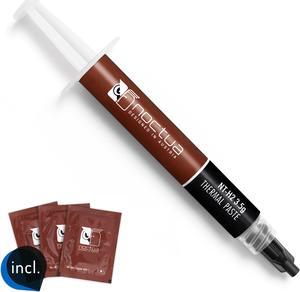
Quick View
Noctua NT-H2 3.5g, Thermal Computer Paste incl. 3 Cleaning Wipes (3.5g)
- Specifications: Premium-grade thermal compound for optimal heat-transfer from the CPU or GPU to the heatsink
- Model #: NT-H2 3.5g
